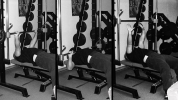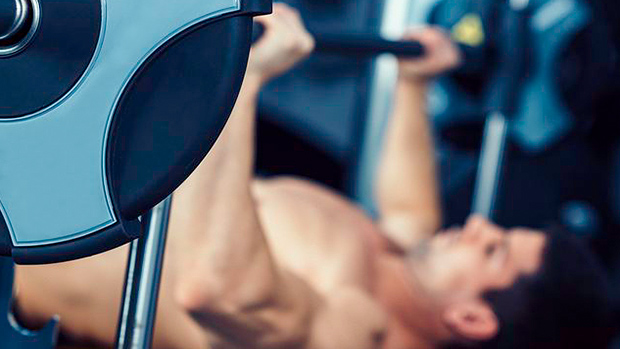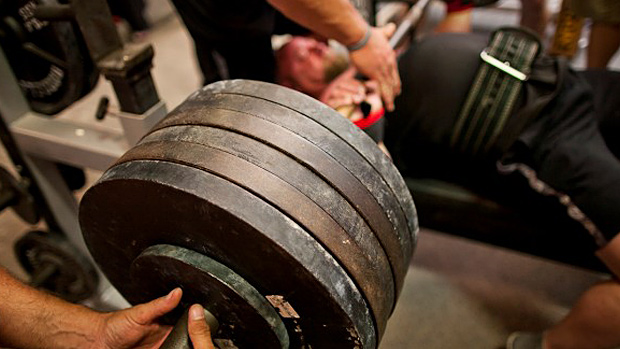Strength Training Percentages
There are definitive Training Percentages for for Traditional Strength Training Movements.
Let's break it down...
1) Speed Training
The Training Percentage needs to be 10-40% of 1 Repetition Max with around 30% being the sweet spot.
Due to the Low Training Percentage, a body or object needs to go airborne.
Failing do so develops Speed in a very small Range of The Movement. The majority of the Movement is devoted to decreasing the Speed.
2) Power Training''
Power Training involves performing a Traditional Strength Training Movement with 48-62% of a 1 Repetition Max.
Ironcially, the term "Speed Training" was inappropriately use; which is incorrect
To optimally develop Power though the entire Range of the Movement, "The Intent" to jump with the weight or project the weight into the air is necessary.
For somone preferring not to go airborne...
Attach Chain and/Or Bands
Attaching Chains and/or Band ensure Power Output/Development through a greater Range of The Movement.
Types of Explosive Power
Fundamentals of Special Strength, Verkhoshansky
These are the three types...
1) Explosive-Isometric Ballistic
This means starting The Movement from a Dead Stop and Exploding up with it.
Examples
a) Power Clean form a Dead Stop off the floor.
b) Barbell Jump Squat performed from sitting on a box with a Dead Stop.
c) Trap Bar Jump from a Dead Stop.
d) Pause Bench Press Throws from a Dead Stop.
2) Explosive Ballistic
The Movement is initiated with some momentum prior to Explosived Up.
Examples
1) Shot Putters generating momentum by spinnig prior to throwing the Shot.
2) Rocking Box Squat. Generating some momentum by rocking forward on the box prior to diving the weight up.
Think of it like getting up from a sofa.
3) Explosive-Reactive-Ballsitic
Reactive meaning eliciting the Stretch Reflex prior driving the weight up.
Examples
Touch and Go Squats off a Box, Rebounding out of the hole in a Squat, Touch and Go Bench Press, Touch and Go Deadlift with a Bounce off the floor
Speed Training
To reiterate, Speed Training is elicited with load of 10-40% of your 1 Repetition Max, with around 30% being the sweet stop.
Thus, a slightly Heavier Load can be used; providing the Concentric Bar Speed doesn't drop down too much.
As with everything, start with something light and easy, then gradually increase it.
From 0 to 100: Know Your Percentages!
Each training percentage, from zero to 100% of your 1RM, has a distinct effect on speed, power, and hypertrophy. Here’s how to use that info wisely.

www.t-nation.com
This article provide some good inforamtion.
Eccentric Speed
1) Heavy Load
As McLaughlin's reseach noted, with Heavy Load in a Squat or Bench Press, the Eccentric Bar Speed needs to slowed down.
Slowing down the Eccentric Bar Speed, decreases the magnification of the Load.
In this scenario, as McLaughlin put it,
"Speed Kills"!
2) Light Loads
With a Light Load, allowing the a Weighted Oject to drop quickly or Free Fall is effective at increasing the load so that the Stretch Reflex is optimally developed.
Plyometric Bench Press Training for More Strength & Power
I am very interested in this. When I plateau with linear progression, I plan on using chains, bands, and stick-weights/small-weights to break over. But I also was thinking of plyometric stuff. I really like the medicine ball drops in the article below. Has anyone done these or similar...

www.elitefitness.com
In this article, a The Medicine Ball Drop is used to elicit and develop the Stretch Reflex. it's effective but I am more of a fan of Smith or Free Weight Bench Press Throws.
As the article notes, a "10 pound medicine ball... dropped from 42 inches (the distance between where the ball is dropped from and the outstretched hands)...elicit a training load of 90 pounds." The article provide the formula this.
The same training effect for the Squats can evoked with Dept Jumps...
Squatting To Be Explosive, Train Explosive
Squatting –To Be Explosive, Train Explosive By Kenny Croxdale, BA, CSCS and Tom Morris MS, CSCS Any questions about this article can be ema...

dbpowerlifting.blogspot.com
"The average heights for depth jumps are 0.75-0.8 meters (27-30 inches). Athletes over 220 pounds should use heights of 0.5-0.75 meters (18-27 inches)." (Dassie, 1999)."




